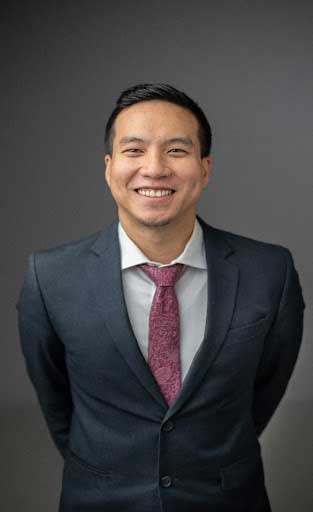 Byron Lai, MS, PhD
Byron Lai, MS, PhD
Assistant Professor, Department of Pediatrics
Heersink School of Medicine Dr. Byron Lai is hard to pin down, both literally and metaphorically.
Bouncing from Oculus headset demonstration to finding a piece of research he admired, or countless other tasks, Dr. Lai can be difficult to track down. You might find him in the UAB/Lakeshore Collaborative building as he’s outfitting his new lab, in his office at Children’s Hospital writing a paper or the next grant, maybe working with patients at Children’s Hospital, or you may find him in one of the many other places that his responsibilities call him to. Regardless of where Lai is conducting his work, he knows exactly why he’s there: a desire to research and help people with disabilities, especially children, find meaningful and enjoyable ways they can improve and maintain their health through telehealth-oriented physical activities.
Like many of the researchers under The Collaborative, Lai was highly sought after and made his way on board soon after he finished his undergraduate degree. While earning his master’s degree in kinesiology from California State Northridge, Lai completed an internship under Dr. Jim Rimmer at the UAB-Lakeshore Collaborative. Soon thereafter, Lai returned to UAB as a student in the rehabilitation sciences Ph.D. program, finishing his degree in three and a half years.
From there, Dr. Lai hit the ground running and completed two post-doctoral fellowships under Dr. Rimmer in The Collaborative, where he was tasked with strengthening the relationship between Lakeshore, UAB and Children’s. Tying all the entities together required research on a younger demographic, something new to most researchers working at The Collaborative. Now with nearly a decade under his belt at UAB, Dr. Lai continues to hone his work with the immense task of taking all that The Collaborative has learned from research on adaptive methods for adults with disabilities and translating them to a child population.
“All of that has to do with telehealth, and Dr. Rimmer is the telehealth king,” Dr. Lai said. Emphasizing his point, Dr. Lai says he is inspired by Dr. Rimmer having conducted the largest randomized controlled trial of adults with physical disabilities ever. “My goal is to be able to do that for kids,” Dr. Lai said with conviction. “I want to conduct the largest randomized controlled trial for children with physical disabilities.”
According to research, adults with disabilities are less likely to participate in health-enhancing physical activity than those without, and the discrepancy is even greater at the child level. But get Dr. Lai talking about potential solutions to this issue, and he’ll immediately burst into a fit of excitement explaining some of the early work he’s done and what it could mean for the future of exercise and physical therapy for children. And it started with none other than a love of video games.
“I loved games.” Dr. Lai said. “I was a gamer my whole life. I grew up with Nintendo, floppy disk games. I wish I grew up now because the gaming experience is just so different.” But with health disparities on top of mind, the Meta Quest headset a low cost virtual reality headset changed the game.
Virtual reality had previously been out of question for most people because the cost of the headset, games, computer hardware and the endless amount of other necessities. But as the headset was becoming more affordable as the world was being turned upside down with the onset of the pandemic, things quickly started lining up.
Formerly a niche alternative, telehealth became mainstream as the world socially distanced as much as possible, furthering the need for alternative approaches. “When the pandemic hit, I was like, ‘We gotta do something for the kiddos,’” Dr. Lai said.
The first step was a case study on the benefits for using virtual reality for therapy. Children’s provided headsets for patients to immerse themselves into a fully virtual world at home. The case study took children in wheelchairs and prescribed them moderate exercise for four weeks, using a Meta Quest virtual reality headset. The results were stunning. The patients surpassed the intensity and amount exercise goals set for them in a population that historically required close monitoring to ensure actual exertion. Now, they were doing that plus some on their own time.
“One kid went two shirt sizes down because he was doing virtual reality boxing every day,” Dr. Lai said. “On average, he was getting [a heartrate of] 159 beats per minute for an hour. That’s insane, so I was like, ‘Oh, my God’ we have to move forward with this.”
The next step is funding from an NIH grant for a full study on about 34 patients. And if everything goes right, Dr. Lai will continue following in Dr. Rimmer’s footsteps and extrapolate it to the largest study of its kind. And this is where it all comes together for Lai; providing valuable research opportunities for the community and the implications of the research findings for a broader group of an underserved population grounds him. Whether it’s at Lakeshore, at Children’s or working with subjects remotely, Dr. Lai’s passion to help others keeps him on path.

